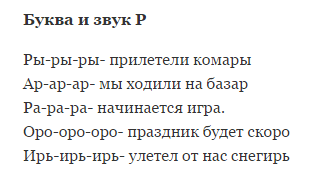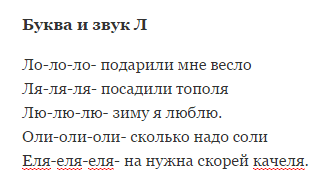A child’s performance at school directly depends on the correct pronunciation and perception of sounds. First of all, this affects phonemic hearing, and subsequently the literacy of oral and written speech. Individual speech therapy sessions with a child are recommended to be carried out at the age of 4-7 years, it is at this age age period in children it is possible without special effort carry out correction of native speech and put the correct pronunciation of sounds.
Speech therapy classes have a positive effect on general development children. You can correct pronunciation problems in oral speech not only with a teacher, but also at home. game form when the child is positively disposed to the activity.

Development fine motor skills has a positive effect on speech development. Playful activities with your child can only be beneficial; this is a great way to combine educational exercises with a fun, encouraging game. These classes teach children to coordinate movements in accordance with words in poetic form, develop speech, memory and imagination. Gesture exercises with hands and fingers develop written speech.
Finger game "Centipedes"

- The centipede's legs hurt (we lower our hands down and relax our fingers).
- Ten whine and buzz (every finger is smooth, we regret it).
- Five are limping and hurting (we feel sorry for five fingers and count at the same time).
- Help the centipede count its sore legs (we count 15 toes by touching them).
- Let the centipede run along a winding path (we move our fingers along the surface).
Articulation gymnastics. - Exercises for the lips and tongue train the muscles and make them more mobile, which contributes to accelerated development correct pronunciation the most complex sounds [zh], [r], [sh], [l], etc..
- Articulation exercises at home can prevent or minimize speech defects. The exercises are best done in front of a mirror so that the child can compare his reflection with the drawing in the picture.
- To help parents, there are various illustrated methodological manuals, where exercises by age category are clearly formulated. Recommendations from some authors: “Articulation gymnastics for the development of speech in preschool children” Anishchenkova E.S. “Articulatory gymnastics in poems and pictures” Kulikovskaya T.A. "Speech therapy massage and articulatory gymnastics» Krause E.N.
Finger gymnastics. Developing your baby's speech and pronunciation
Games with sounds
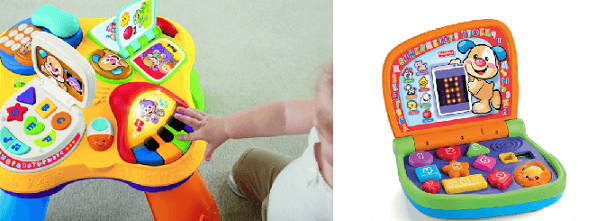
Hearing, pronouncing and distinguishing sounds correctly means having excellent phonemic hearing. Impaired phonemic hearing in children leads to dysgraphia (impaired writing) and dyslexia (impaired reading), so you should pay attention to the pronunciation of sounds and promptly correct defects in the preschool period. Exercises for children in a playful way will help parents prepare their child for school.
Game "Funny Pictures"
Place several cards with thematic images of objects;
Game 1. Ask your child to point to pictures in the names that have a given sound, for example [s].
Game 2. Ask your child to choose an extra picture where there is no given sound, for example, rocker, crane, flower, mole, pyramid (main sound [p]).
This game can be played not only with images in drawings, but also with real objects, for example in a room.
Simple sayings
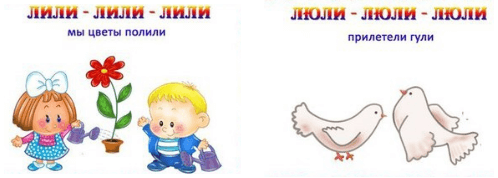
Exercises in the form of various rhymes correct unclear pronunciation of sounds. The rhyme of a pure tongue consists of difficult combinations of letters and sounds, therefore, for correct pronunciation, the child uses different positions of the tongue and lips, thereby training and improving diction.
Pure sayings for children 6-7 years old
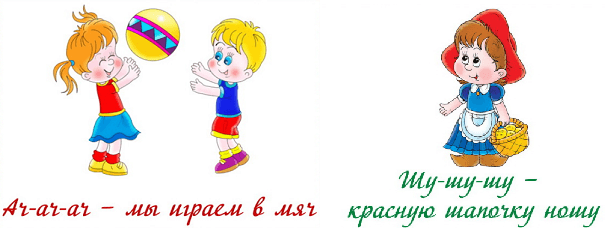
Hissing letters and sounds are often pronounced in violation of phonetics.
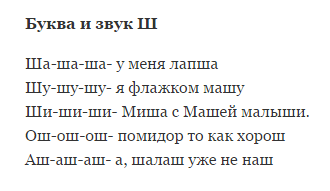
Basic exercises:
- Rhythmic walking accompanied by poetry or music.
- Musical speech games; rhythmic singing to the beat of the music.
- Psychological gymnastics; pronunciation of rhythmic phrases with the expression of actions of their content, using motor and facial gestures.
- Breathing training.
- Finger games.
- Logorhythmic exercises for children are usually performed in groups under the guidance of a teacher, but you can start preparing to inform the child at home.
- The essence of the exercises comes down to repeating rhythmic movements and poetic phrases after an adult.
Logorhythmics
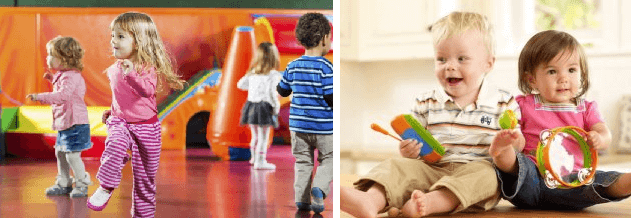
Exercises for speech therapy rhythm develop in children the ability to coordinate movements in accordance with the rhythm of musical, poetic or verbal accompaniment. This method comprehensive development the child has a positive effect on the physical and psychological health. Daily classes help correct phonetics and speech disorders, develop coordination and attention.
Logorhythmics Poems for children's speech development
The topic of producing sounds in five-year-old children, which worries many parents and is far from the simplest in itself, requires careful consideration. Speech therapy classes for children are often given very little attention and completely in vain. Adults brush it off, saying that it will go away on its own with age, but it may not go away. Often, an adult’s clumsy speech takes its origins from these children’s “dropouts.”
The development of speech in a child should begin with preschool ageIncorrect, unclean speech creates, first for the child, and then for the adult, a lot of complexes. He becomes withdrawn and uncommunicative. Hurry to correct the shortcomings now to help your baby avoid similar problems in the future. This can be done at home too. The home environment liberates the child and makes it easier for him to study freely. We will bring to your attention a number of useful and interesting games, which you can organize yourself.
Types of defects
Let us first turn to the main types of speech disorders. There are a huge number of them, but each one ultimately becomes unique, as it belongs to a specific child:
- Stuttering. This phenomenon occurs most often. You can notice it closer to three years, when the child begins to build his first large sentences. To correct the defect, it is better to immediately contact a specialist. It is also important to monitor your progress and not give up. game exercises, because there are cases when the “disease” returned again.
- Dislalia (we recommend reading:). This tricky word means nothing more than confusion in the pronunciation of individual consonant sounds. Most often this phenomenon covers the sounds “r”, “l” and “sh”.
- Nasality. This phenomenon also occurs among defects, but most likely the problem lies precisely in the incorrect structure of the speech apparatus, then mom and dad have a direct path to an ENT specialist, who will try to solve it and correct it as much as possible.
- General underdevelopment of speech or. Often this phenomenon is deeply connected with the wrong approach in communicating with the child. In a family with a baby, they often babbled and distorted words and endings. All this created enormous confusion in the child’s head and now he himself constantly confuses prepositions, endings, etc. Hurry up to fix it, because school is just around the corner!
- Congenital diseases of neurological origin. IN in this case consultation and treatment with a neurologist is strictly necessary.
- Delay speech development or ZRR. This disease can manifest itself closer to the age of three. The average child usually speaks a lot and incessantly at this age, but if there is a clear paucity of speech, it is worth visiting a specialist for consultation.
Stay alert at all times. From yours close attention no flaws should escape. If you notice something is wrong, do not delay treatment, but contact experienced doctors as soon as possible.
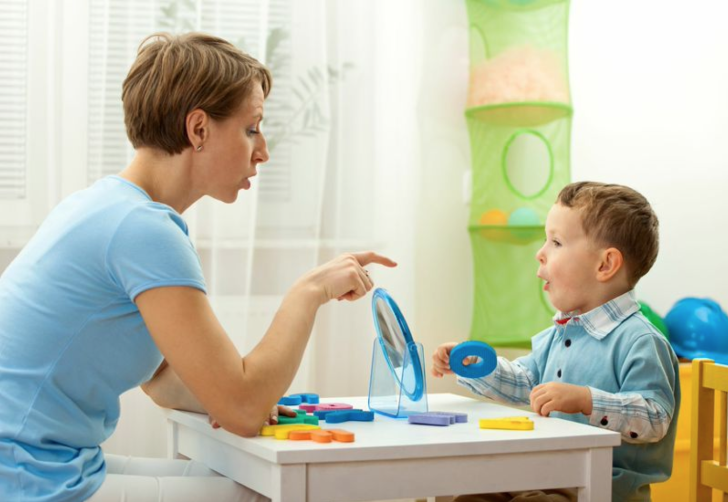 If the poverty of a preschooler’s speech is noticeable, you need to consult with an experienced speech therapist - it is possible that certain deviations will be identified
If the poverty of a preschooler’s speech is noticeable, you need to consult with an experienced speech therapist - it is possible that certain deviations will be identified Help from a speech therapist: when is it time?
We must sadly admit that modern means of communication, such as television and computers, have abruptly and thoroughly replaced communication from life. Reading books has been reduced to a minimum, but watching TV shows and cartoons takes almost half a day. Children communicate too little both with their parents and with each other. TV offers a wide range of everything interesting and exciting, which means there is no point in looking for other ways to obtain information.
This is where problems with sound pronunciation arise. They occur more and more often, and the problem sometimes gets worse quickly. Behind the TV and monitor, a parent may not notice that the child needs help, but it should be provided the sooner, the better. Any problem, in particular speech therapy, cannot be delayed, then the opportunity to correct what is wrong and deliver correct speech increases significantly.
Home speech therapy classes
Most often, speech therapy specialists are visited by parents with children after the age of four. This is the age when children can already master the pronunciation of complex consonant sounds, and also know how to construct logically complete sentences. At the age of six, a child can easily construct a story - for example, from a picture. Is this task too much for your child? This is a reason to worry and ask for help from a specialist.
Getting a diagnosis from a speech therapist or other specialist will involve attending classes - usually several times a week. It is imperative to follow the schedule, otherwise achieving sustainable results will be quite difficult.
Perseverance and perseverance will certainly bear their worthy and pleasant fruits in the form of pure speech. It is advisable to play games at home in good mood and do not force the baby to study against his will. We will bring to your attention interesting and useful exercises that can be done at home, starting from the existing problem.
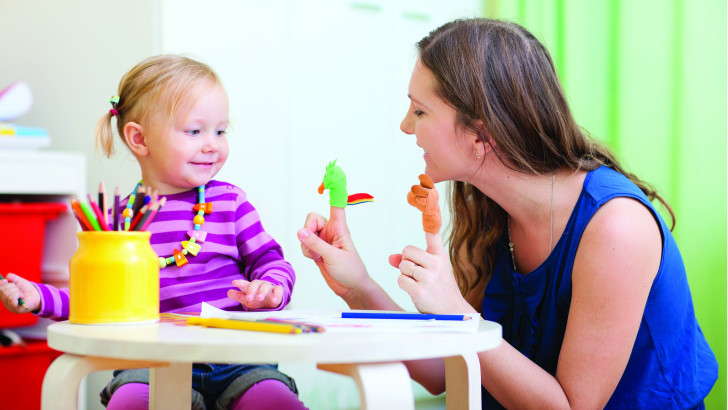 Parents can also study with their child at home using educational materials.
Parents can also study with their child at home using educational materials. For pronunciation of sounds
Most often, the sounds L, R and Sh fall into the field of activity of a speech therapist. They are the most insidious. The baby may at first simply miss them in words and not say them. This is a variant of the norm; over time, the baby will master these sounds, but the situation becomes more complicated when the child chooses easier sounds to replace them and replaces them with difficult ones to pronounce.
Sound R
It is important to stretch the entire articulatory apparatus before games. Everything should work for children - the tongue, the lips, and the palate. Let's start with the sound R. The following exercises will be good helpers:
- You should open your mouth wide and smile in this position. The lower jaw remains motionless. The tip of the tongue makes stroking movements along the upper palate back and forth. Practice yourself so that you can later explain this to your child more clearly and understandably.
- The tip of the tongue makes cleaning movements of the tooth with them inside. The mouth is open wide. A correct explanation will help any 5-year-old to cope with this exercise.
- A good exercise would be this developmental option. A small ball with a hole should be placed on a stick. We ask the little one to open his mouth and say: “DDRR”. At this moment, you need to move the ball under the tongue. Movements must be fast.
- The child is given the task to say the word “yes”. The tip of the tongue rests against the upper teeth. Then the sound “Dy”, now the tongue rests on the upper palate.
The training video that you will see below will help you to correctly place the articulation to pronounce the sound “r”. Let's move on to the next difficult sound.
Sound L
We pronounce the sound “L”:
- The mouth is wide open and the tongue lies on lower lip. Helping yourself with your hand, supporting your chin, pronounce the syllables “la”, “lo”, “li”, “lu”.
- Make coloring movements with your tongue across the surface of the palate.
- Invite your baby to reach the tip of his nose with his tongue.
- We lick our lips as if there was jam left there.
Sound Sh
Let's move on to the complex sound "SH":
- Place the very tip of the tongue under upper lip. Now a sharp jerk downward, you should get a loud click.
- Pull the sponges forward with a tube and freeze in this position for about 7 seconds.
- Place a small piece of cotton wool on the baby's nose and offer to blow it off. The baby's task is to lift the fleece up. This exercise is very fun and your baby will surely enjoy it.
These were exercises on articulation and correct production of sounds. Below we will look interesting options exercises for daily developmental activities.
Activities for clear speech
Five-year-old children are already very smart and are excellent at repeating after adults and reproducing even very complex actions. Indeed, articulation tasks can sometimes be quite difficult. We have excluded all the most difficult ones and left only those exercises that are easy to perform and at the same time very effective. They will be an excellent workout for children with special needs.
Articulation gymnastics
- Smile widely, showing everyone your teeth. Then we pull the lips forward with a tube.
- Tighten your lip muscles as much as possible, then smoothly relax.
- Lightly bite the lower and upper lips alternately.
- We use our tongue to depict the clatter of hooves. All kids love to do this.
Warm-up time will take no more than 15 minutes. All exercises will be useful not only for children, but also for adults who have some problems with diction.
We will also offer fun and effective speech games for children 5-6 years old for correct sound pronunciation:
- Play the baby's cry: "Wa-wa!"
- We squeal like mice: “Peep-pee-pee.”
- We scream as if we were lost in the forest: “Ay! Aw!”
- We hum like the wind in the mountains: “Uuuuu!”
- We combine vowels and consonants. We scream like animals: “Meow”, “Woof”, “Kwa-kwa”, “Ga-ha-ga”.
- We growl like bears: “Rrrrr!”
- We sing a song: “La-la-la, la-la-la.”
By the way, singing is very useful for learning correct speech. Any favorite song will come in handy. Many children really love songs like “There was a birch tree in the field” or “Two cheerful geese lived with grandma.” They will be excellent helpers, because there is a smooth stretching of sounds, and this is a great thing for correcting pronunciation. It’s not for nothing that in kindergartens educational program, music classes are necessarily included, although they do not exclude the activities of the speech therapist present there.
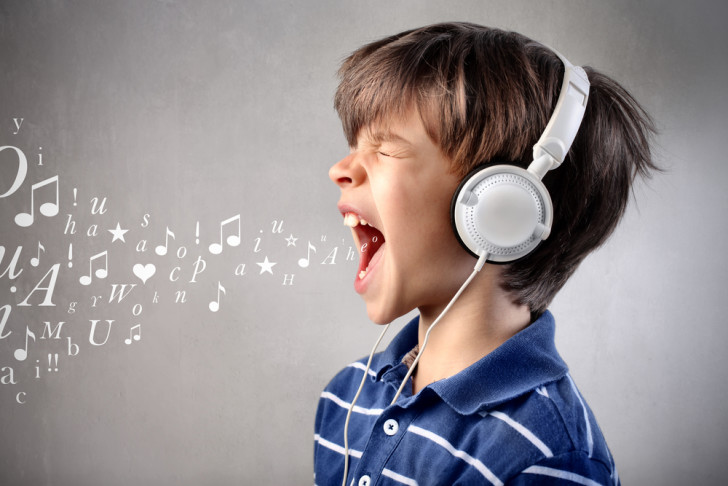 Singing, even amateur, helps a child quickly develop correct speech skills
Singing, even amateur, helps a child quickly develop correct speech skills Kindergarten classes
In kindergartens, as a rule, speech therapy games are held, which are divided into 2 main types:
- Individual. When a certain child has a problem that needs to be solved.
- Group. Classes are held simultaneously with several children who have similar speech defects.
Such classes are necessary in every preschool institution, but the truth is not everywhere. Closer to school age, speech therapy classes become mandatory, because preparation for school is underway. Chanting will be a great workout. They seem to be songs, but not simple ones. Sound pronunciation occurs along with the performance of certain actions.
Good game "Flying Plane". The kids imitate the sound of a flying airplane in unison: “Uuuuuu!” At the same time, to be convincing, you should spread your wings. We command:
- The plane flies closer (the hum becomes louder), the plane flies away (the sound becomes quieter).
- Breaking! Simultaneously with the humming, babies hit themselves on the chest with their palms.
- We're about to land! Continuing to hum: “Uuuuu!” airplanes land and sit on their seats.
Practice with a microphone. Try showing your children how the volume of sound changes when we move the microphone closer or further away.
Remember that most problems can be solved. The main thing is not to neglect or leave everything to chance, but to engage and develop, then even diagnoses like mental retardation or mental retardation will not seem so scary.
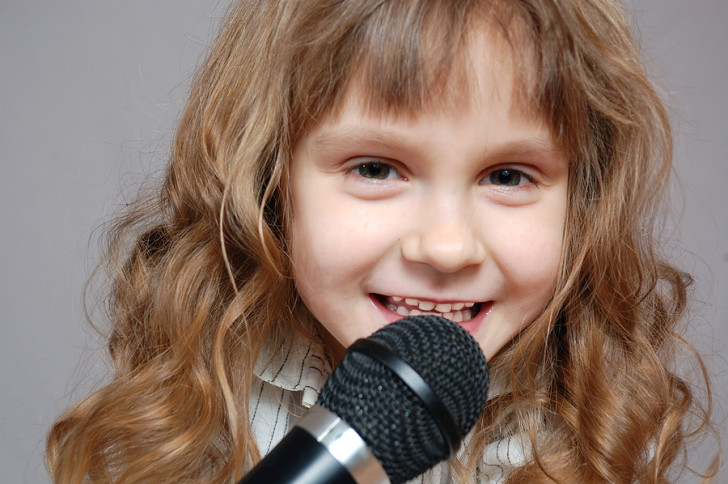 Working with a microphone allows you to develop a child’s artistry, and gives him the opportunity to hear his speech from the outside
Working with a microphone allows you to develop a child’s artistry, and gives him the opportunity to hear his speech from the outside When the doctor diagnosed “ZPR”
In addition to parents who are ready to independently find a lot of shortcomings in their little one, there are also those who, on the contrary, do not notice the obvious. At five years old, a child should be able to express his thoughts freely and coherently. Confusing syllables in words at this age is unacceptable.
Here are a number of diagnoses, the formulation of which often frightens parents:
- ZRR. With this diagnosis, only the pronunciation side lags behind in its development. Mental functions are not impaired. Early diagnosis will prevent RRD from developing into ZPRD.
- ZPRD – delayed psycho-speech development. In this case, not only speech suffers, but also the psyche, and with it mental abilities.
- ZPR - delay mental development. An extensive diagnosis that, among other areas, also affects the child’s pronunciation skills.
When making one of the diagnoses, you should seek help from specialists as soon as possible, because the sooner the treatment process begins, the faster and more effective the rehabilitation will be. Neglect can occur in any type of disease, so do not delay starting therapy.
Loving parents should first of all create a positive and calm external environment for the child, and also start looking for smart doctors. Here, most likely, you will need a speech therapist and a neurologist. Below we provide a small list of didactic literature that can be very useful during corrective exercises with a child.
Literature
When someone in the family has speech defects, didactic thematic books must be at hand and on the shelves. Competent authors offer sets of lessons for speech therapy games that will be very useful.
- “Speech therapy homework for children 5-7 years old with OHP”, author Teremkova N.E. This is the first of four albums. Each album is dedicated to specific lexical topics.
- “Speech therapy group: play sessions with children 5-7 years old,” author Derbina A.I. The best way to teach a child something is through play. A playful form of presenting material would be appropriate for preschool children. This book is suitable for parents of children with complex speech defects.
- “Speech therapist lessons. Games for speech development”, author Kosinova E.M. This book also offers a playful form of presenting the material, and another big plus is that it can be used with children absolutely of different ages: from 6 months to 6 years! The book contains tasks for finger and articulation gymnastics.
- “Encrypted tongue twisters. Sweetie”, author Kodolbenko E.A. Many interesting proverbs like “There is grass in the yard, there is firewood on the grass” will definitely be appreciated by your child.
- “Fun Logorhythmics”, author Zheleznova E. The audio guide is aimed at developing the child’s correct sound pronunciation, as well as fine and gross motor skills, in a playful way.
Developmental activity for children 5-6 years old
Methodological development classes for older preschoolers: “We can do a lot!”
Description: Developmental lesson “We can do a lot!” is intended for children of senior preschool age. Conducted by an educational psychologist to prepare children for school. The development of the lesson can be used by educators and additional education teachers.
Purpose of the lesson : Development of cognitive activity of preschool children at the stage of preparation for school through play activities.
Tasks:
1. Teach children to solve the tasks assigned to them in a playful way.
2. Promote development creativity, imagination, attention, child’s speech, development of a sense of cohesion.
3. Cultivate interest in future school life, awaken interest in one’s own personality, and develop a positive interest in learning.
Children's age: children 5-6 years old
Type of activity : combined.
Methods : verbal, visual, practical (exercises, game).
Preliminary work : prepare the following educational and methodological support for the lesson:
Mittens cut out of paper with different patterns
Newspaper
Drawings of a bicycle, letter, boots, hat, book, umbrella, hammer and nail
Equipment:
Blackboard, pencils for children
Progress of the lesson:
I. Introductory part
I.1. Greeting "Hello, everyone with braids"
Who has sisters, who ate candy today, who behaved well today and who behaved poorly, who blonde hair. (Children instead of answering “yes” say “hello”).
II. Main part
II.1. Exercise “Say it in one word”
Target : development of the cognitive sphere
Carrying out : Let's check if you are ready to work. Now I will tell you words, your task is to name them in one word (children answer in turns)
Faith, Hope, Elena, Love
January, March, July, September
A, B, C, C, N
Monday, Sunday, Thursday
Table, sofa, chair, bed
Flip flops, boots, shoes, shoes
Ox, bear, hedgehog, fox
Chicken, heron, pigeon, swallow
Dandelion, clove, chamomile, clover
Hammer, screw, saw, screwdriver
II.2. Exercise-game “Mittens”
Target: developing the ability to interact with peers and negotiate a common cause. Establishing emotional contacts in a group
Carrying out : to play the game you need to cut out mittens from paper, the number of pairs is equal to the number of pairs of participants in the game. Each pair of mittens has an ornament painted on it that is not similar to other mittens. The presenter lays them out around the room. On command, the children scatter around the room, find their pair, take pencils (three colors), and try to color their mittens as quickly as possible, having previously agreed on what colors the ornament will be painted in so that the mittens are the same. The winner is the pair of children who paint their mittens the same color the fastest.
II.3. Physical education lesson “Grasshoppers”
Physical education minute. Stork(Back straight, hands on waist. Children smoothly and slowly raise either their right or left leg, bent at the knee, and also smoothly lower it. Watch their back.)- Stork, long-legged stork,Show me the way home. (The stork answers.)- Stomp your right foot,Stomp your left footAgain - with the right foot,Again - with the left foot.After - with the right foot,Then - with the left foot.And then you will come home.
II.4. Exercise “How to use...”.
Target : development of imagination, creative thinking.
Carrying out: The presenter names an object and invites the children to say how it can be used. Example: newspaper - read, write, build a boat, lay it on the floor, use it as a toy, tear it for a cat, make a hat on its head, just tear it, etc.
II.5. Exercise “What does this word mean?”
Target : development of thinking, speech
Carrying out : There are drawn objects in front of you. Imagine a person who does not know the meaning of any of these words (you can sit a toy and tell it). Try to explain to him the meaning of each word, for example, “Boots” are waterproof shoes for walking through water and mud.
III. Final stage
III.1. Lesson reflection : what exercise did you like best, what did you not like.
The results of the children’s task completion, their activity, and answers show that the goal of the lesson has been achieved.
Exercises for children aged 5-6 years are characterized by simplicity. But it is already important to demand that children complete tasks accurately. Adults monitor compliance with the starting position, as well as the clarity and consistency of the movements of the arms and legs. It is important to ensure that correct posture is maintained throughout the workout and after its completion.
Children of the sixth year of life acquire the skills to independently evaluate their movements. This is facilitated by doing exercises in front of a mirror. The coach should tell the child when to inhale and exhale. This will help ensure smooth and spontaneous breathing.
To make classes fun and interesting, choose fun music. Accompany all movements with energetic counting and fascinating poems. Exercise only in a good mood. Don't forget to praise your baby.
Classes for children 5-6 years old last no more than 25 minutes. The complex must include at least 8 exercises for different parts body and muscle groups. The number of repetitions is at least 6 times.
Strengthening the arms and shoulders of babies:
The starting position is as follows:
The baby should stand straight
Legs together or slightly apart
Handles down
Exercise "Wings"
From the initial position of the body, the child raises his arms through the sides, pointing his palms towards the ceiling. Then the child returns his hands down, turning his palms down.
Exercise "Handles up"
From the starting position, the child should raise his arms up, with his palms pointing down. When the hands are up, the baby raises his head, looking at his palms with his eyes. Next, the handles go back down through the sides.
Exercise "Clappers"
While in the starting position, the baby should raise his arms up from the sides and clap his hands. In the same way, the child lowers his arms back, puts them behind the back and tries to clap his hands from behind. After completion, the handles are returned to the starting position.
Exercise "Strong arms"
The child spreads his legs a little wider. The baby should raise his arms to the sides, squeeze them at the elbow joints, while clenching his fists. Then you should spread your arms to the sides, unclenching your fists. Return to starting position.
Exercise "Boxer"
From the starting position, the child bends his arms in front of his chest, imitating a boxer. The baby should alternately straighten and bend his arms, constantly accelerating the pace of delivering “strikes”. During the exercise, the child's body should sway slightly from side to side.
We train the torso:
The baby is standing upright
handles on the waist
legs slightly apart
Exercise "Turn around"
From the starting position, the child leans to the right and returns to the starting position. The same should be done to the left side.
Exercise "Lumberjacks"
Lower your hands down, then lift them up, clasping your fingers above your head. Then you should quickly bend down, lowering your joined hands between your legs. Return to starting position.
Exercise "Bend Over"
From the starting position, the child should alternately bend over in the following sequence:
to the toe of the right leg
between your legs
to the toe of the left leg
At the end, return to the starting position of the body.
Exercise "Stork"
From the starting position, the child should bend one leg at the knee, clasp it with his arms, touching his forehead to the knee. Do the same with the other leg.
Exercise "Reach for the ball"
The baby is placed on his tummy. He holds the ball in his arms extended forward. Then the child must raise his head, shoulders and arms with the ball up to the maximum height. Stay in this position for 3 seconds and lower yourself down.
Strengthening the legs:
The starting position is as follows:
The baby is standing upright
legs slightly apart
feet parallel to each other
handles on the waist
Exercise "Squats"
From the starting position, the child should squat as low as possible, with his arms extended forward. Then rise up, returning the handles to your waist. It is important to ensure that the baby’s back remains straight during such squats.
Exercise "Spring"
From the starting position, perform 3 shallow squats in a row. The child's arms should swing freely along the body.
Exercise "Clap under the knee"
From the starting position, you need to lift one leg, bent at the knee joint. Then do a clap under the knee. Return to starting position. Do the same with the other leg.
The following exercises are effective for training your legs:
"Stork"- walking with high knees
"Duck"- walking on bent legs
Developing balance:
The following exercises perfectly train a child’s balance:
Walking on a bench
walking on a log
When performing such tasks, invite your child to change the position of his hands: in front, at the waist, in different sides. You can complicate the exercise with new steps: side steps, with your knees raised high, your backside, with your torso turned to the sides, etc.
We play and develop with equipment:
Most effective exercises for children 5-6 years old are:
tossing a ball. The kid throws the ball up, then catches it with both hands
basketball. It is necessary to hang the basket at a short distance from the ground. Invite your child to throw a ball into it from a distance of no more than 2 meters
exercise with a stick. The kid picks up a gymnastics stick. At the command of an adult, he raises the stick up, holding it with both hands. Then you need to raise the stick forward
jumping over an object. You need to take any small item. Invite your child to place it near his toes and then jump over the object back and forth. The same can be done by jumping on one leg at a time
Pay enough attention to the physical development of your kids. This will help improve their health!
For children 5-6 years old. I hope you have already successfully completed the lessons for ? September lessons are coming up.
In fact, the division by month is quite arbitrary; the tasks are simply “tied” to the month of the year to make it more interesting. And so, you can use tasks from any month for the development of your child.
In parallel with schoolchildren, classes began in kindergartens and experienced teachers teach children there using their own methods. But, nevertheless, parents should not distance themselves, and on Saturday morning, after watching morning cartoons, it will be useful to spend half an hour with their child and work with him additionally, and at the same time check his level of development (in some collections of developmental activities there are mini tests) . So shall we begin?
Changes in nature in September.
- For communication with your child and developmental activities, it is best to use walks in the fresh air. Teach him to observe what changes in nature occur with the onset of autumn.
Pay his attention to the fact that with the onset of autumn, the sun no longer shines so brightly, it has become cooler, butterflies and other insects have disappeared, swifts and swallows are no longer visible in the cities, i.e. The flight of birds to warmer regions began. The leaves on many trees and shrubs have turned yellow or red, the flowers in the meadows have bloomed, a cold wind often blows, and it is drizzling.
- In a park or square, find and examine spruce, linden, maple, birch, oak, and rowan. Draw the child's attention to characteristic features of these trees: bark, leaves, fruits and seeds. Offer to collect from falling leaves autumn bouquet. At home, place the bouquet in a vase. Let your child try to trace and color individual leaves, and then work with him to draw a still life with a bouquet of leaves.
Tell your child riddles about trees:
Developmental activities.
- Improving object comparison skill in size, invite the child to look at the picture and compare first the height, and then the thickness of oak and rowan. You can also suggest comparing the lengths of the branches of these trees.
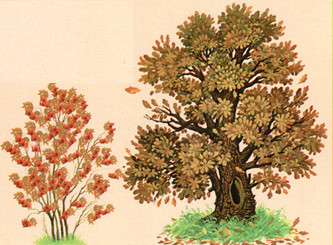
(The oak is tall, and the rowan is low. The oak is taller than the rowan. The rowan is lower than the oak. The oak is thick, and the rowan is thin. The oak is thicker than the rowan. The rowan is thinner than the oak. The oak has long branches, and the rowan has short ones. The oak branches are longer than the rowan branches. The rowan branches are shorter oak branches.)
- Improving plane orientation skill, training a child in use of prepositions, invite him to look at the picture and tell where each of the animals is.
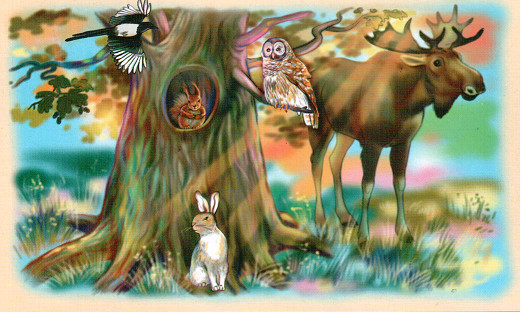
(A squirrel sits in a hollow. An owl sits on a branch. A hare sits under an oak tree. A magpie flies in front of an oak tree. An elk stands behind an oak tree.)
Educational games.
Developing grammatical structure of speech child, teach him to form the plural form of nouns. Offer him an educational game:
- You throw a ball to your child and name a tree, vegetable or fruit. He catches the ball, forms the plural form of the noun, and returns the ball to you.
For example:
Invite your child to name what is shown in the picture, and then form the plural of the name.

An educational game to develop a child's mathematical understanding.
- Offer to place oak and maple leaves collected during a walk on the carpet in a loose order. Check in advance to make sure there are equal numbers. For example, five. Let the child count first the oak leaves and then the maple leaves and draw a conclusion about their number:
“There are five oak leaves. There are also five maple leaves. This means oak and maple leaves equally - five each.”
Now let him think about how to arrange the leaves so that it immediately becomes clear that there are equal parts. He should arrange the leaves in two rows in pairs.
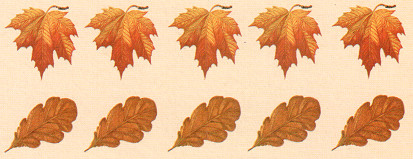
Ask your child to think about how to make one more oak leaves and one less maple leaves. The child must offer two options:
add one oak leaf or remove one maple leaf.
Let him count how many leaves of each type there will be in the first and second cases.
When telling your child about what happens in the life of wild animals in the fall, read to him the fairy tales of V. Zotov (from the book “Forest Mosaic”). They will enrich the child’s understanding of the animal world. Here is one of the fairy tales.
Lynx
- Knock, knock, knock! - Woodpecker knocks in the forest.
- You were missed here! - Lynx exclaimed. “I was just getting ready to rest, and he knocked.”
A wild cat the size of a dog was lying on the trunk of a fallen tree. She had thick fur hanging down the sides of her head, and tassels adorned the tips of her ears. The animal's tail is short, as if cut off at the end. The lynx stretched out its long legs with wide paws.
Sorry,” the man sitting on a nearby tree politely bowed his head.
Woodpecker.—It’s very difficult to see you. A spotted coat makes you almost
unnoticeable among the sun's glare falling on the ground. Sorry again.
The woodpecker flew a little higher.
“But still, let me treat this tree,” he asked and explained: “There are many bugs sitting under its bark.” And to get them, I need to poke them a little with my beak.
- If so, then I don’t mind. We must always come to each other’s aid,” Lynx stood up and jumped to the ground. “I’ll rest in another place.”
Stepping carefully, the predator headed deeper into the forest.
...Lynx hunts many animals and birds. It will hide somewhere behind a fallen trunk, an old stump, or sit on a thick branch on a tree and wait for prey to appear. And then he rushes at her with big leaps. The lynx usually does not attack a person; it tries to hide from him in dense thickets.
 When checking how your child has learned what he read, ask him questions.
When checking how your child has learned what he read, ask him questions.

